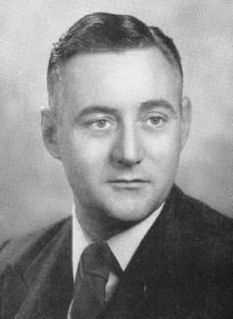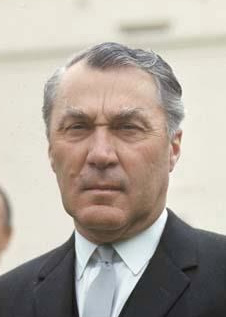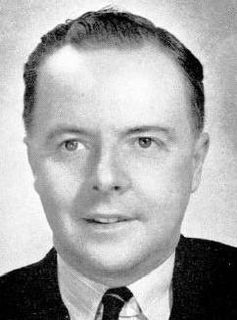Related Research Articles

Joseph Benedict Chifley was an Australian politician who served as the 16th prime minister of Australia from 1945 to 1949. He held office as the leader of the Australian Labor Party (ALP).

William Guy Higgs was an Australian politician who served in both the Senate and the House of Representatives. He was a Senator for Queensland from 1901 to 1906, and then represented the Division of Capricornia in the House of Representatives from 1910 to 1922. He served as Treasurer of Australia from 1915 to 1916, under Billy Hughes.

Anthony Sylvester Luchetti, AM was a long serving Australian federal member of parliament.

Philip Ernest Lucock, CBE was an Australian politician and Presbysterian minister. He served in the House of Representatives from 1952 to 1980, representing the Division of Lyne for the Country Party. He was Deputy Speaker for a record span of over 13 years.

Francis (Frank) Matthew John Baker was an Australian politician and vice-president of the State Service Union.

Sir Robert Carrington Cotton, was an Australian politician and diplomat. He was a member of the Liberal Party and served as a Senator for New South Wales from 1966 to 1978. He held ministerial office as Minister for Civil Aviation (1969–1972), Science and Consumer Affairs (1975), and Industry and Commerce (1975–1977). He later served as Consul-General in New York (1978–1982) and Ambassador to the United States (1982–1985).

The 1954 Australian federal election were held in Australia on 29 May 1954. All 121 seats in the House of Representatives were up for election, but no Senate election took place. The incumbent Liberal–Country coalition led by Prime Minister Robert Menzies defeated the opposition Labor Party led by H. V. Evatt, despite losing the two-party preferred vote. As well as being the only election in which a party received a clear majority of votes and was unable to form government.

The 1951 Australian federal election was held in Australia on 28 April 1951. All 121 seats in the House of Representatives and all 60 seats in the Senate were up for election, due to a double dissolution called after the Senate rejected the Commonwealth Bank Bill. The incumbent Liberal–Country coalition led by Prime Minister Robert Menzies defeated the opposition Labor Party led by Ben Chifley with a modestly reduced majority, and secured a majority in the Senate. This was the last time the Labor party ever held a Senate majority. Chifley died just over a month after the election.

John Norman Lawson was an Australian politician. He was a member of the United Australia Party (UAP) and served in federal parliament from 1931 to 1940, representing the Division of Macquarie in New South Wales. He was Minister for Trade and Customs in the first Menzies Government from 1939 to 1940.

Nelson Lemmon was an Australian politician. He was a member of the Australian Labor Party (ALP) and served as Minister for Works and Housing (1946–1949) in the Chifley Government. He played a key role in establishing the Snowy Mountains Scheme.

Albert Lane was an Australian politician. He was a Nationalist Party member of the New South Wales Legislative Assembly for Balmain from 1922 to 1927 and a United Australia Party member of the Australian House of Representatives from 1931 to 1940.

Eli James Harrison was an Australian politician. Born in Port Macquarie to farmer William Binney and Sophia Selina Turnbull, he was educated at state schools. He then worked on a dairy farm before joining New South Wales Government Railways in 1925. He was an official of the Australian Federated Union of Locomotive Enginemen from 1930 to 1949, and was its president in 1948. He was active in local Labor Party politics, and was elected to the New South Wales Legislative Council in 1943. He held that position until 1949, when he transferred to federal politics, defeating former Premier Jack Lang for the new seat of Blaxland. He held the seat until his retirement in 1969. He first married Una Grace May Brown at Pleasant Plains, near Port Macquarie, on 15 October 1924, three days after reaching adulthood. This marriage was dissolved on 6 July 1968. He subsequently married Joyce Ethel McGovern on 7 September 1975 at North Melbourne, but died the following year.

Francis James Foster was an Australian politician, representing the Division of New England in the House of Representatives for the Australian Labor Party from 1906 to 1913.

Edward Riley was an Australian politician. He was an Australian Labor Party member of the Australian House of Representatives for South Sydney from 1910 to 1931.
The 1952 by-election for the Australian House of Representatives seat of Lyne was called on 22 March after the death of the incumbent Country Party of Australia member Jim Eggins who died in office on 28 January.

Arthur William Hutchin, DSO was an Australian businessman, politician and army officer. He was a United Australia Party member of the Australian House of Representatives from 1931 to 1934, representing the Tasmanian electorate of Denison.

James Guy Dalley Arkins was an Australian politician.
This article provides information on candidates who stood for the 1954 Australian federal election. The election was held on 29 May 1954. There was no election for the Senate.
George Roy William McDonald was an Australian politician.
The Federal Labor Party were the members of the Australian Labor Party in the state of New South Wales who supported the federal party leadership in the split with the state Labor party which broke away in 1931. Federal Labor retained some seats in the Parliament of Australia but was a minor party in state elections. The dispute was healed in 1936.
References
- ↑ Adam Carr. "Commonwealth of Australia Legislative Election of 19 December 1931". psephos. Adam Carr. Retrieved 2 May 2011.
- ↑ Adam Carr. "Commonwealth of Australia Legislative Election of 15 September 1934". psephos. Adam Carr. Retrieved 2 May 2011.
- 1 2 Adam Carr. "Commonwealth of Australia Legislative By-election of 1951 - Macquarie". psephos. Adam Carr. Retrieved 2 May 2011.[ permanent dead link ]
- ↑ Adam Carr. "Commonwealth of Australia Legislative Election of 29 May 1954". psephos. Adam Carr. Archived from the original on 2 September 2006. Retrieved 2 May 2011.